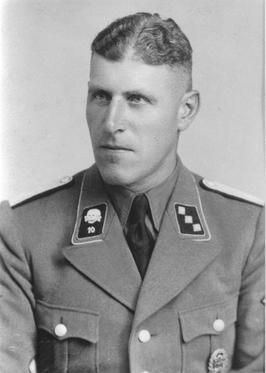Name Hans Huttig | ||
 | ||
Hans Hüttig (born 5 April 1894 in Dresden – died 23 February 1980 in Wachenheim) was a German Schutzstaffel (SS) officer and Nazi concentration camp commandant.
Contents
Early years
Hans Hüttig was born on April 5, 1894. The son of a carpenter, Hüttig's father would eventually open a shop selling photographic equipment and this became the family trade, with Hans Hüttig's brother a founder of Zeiss Ikon. Sent to a boarding school in south Germany he attempted to enter the army in 1911 but failed the exam and returned home to work as a salesman in his father's shop. Early in 1914 he left the shop to take a post with an import-export company in German East Africa.

Following the outbreak of the First World War Hüttig enlisted in the German Imperial Army, seeing action in the East African Campaign and eventually rising to the rank of Feldwebel. Wounded in December 1917, the military hospital where he was being treated was captured by the British Army. Thereafter, Hüttig was sent to a POW camp in Cairo where he was held for two years.
Joining the Nazis
He returned to Germany in March 1920, working initially at the shop again before filling on a number of clerical jobs. Hüttig joined the right-wing Stahlhelm, Bund der Frontsoldaten in 1925 although he claimed that this was largely to feel a sense of belonging rather than because of any deep political convictions. After running his own photography shop (which closed in 1930), Hüttig enlisted in the SS in March 1932 at age 37 as an unpaid volunteer and he joined the Nazi Party soon afterwards.
Concentration camps
Following the Nazi seizure of national power in 1933, Hüttig was offered and accepted a full-time billet with the SS as part of the SS-Totenkopfverbände (SS-TV). For the next six years Hüttig spent his time touring the concentration camps and being trained for a career in them. His first assignment came when he was appointed deputy to Karl Otto Koch, commandant of Buchenwald concentration camp and a man already known to Hüttig from Dresden. At Buchenwald Hüttig was praised by his superiors for his attitude whilst inmates would later testify to his personal cruelty.
After his time at Buchenwald, Hüttig saw service at Sachsenhausen concentration camp and Flossenbürg concentration camp and in both garnered a reputation as a troubleshooter who was suitable for special tasks. Thus he was called upon to oversee the construction of a new facility at Natzweiler-Struthof in Alsace. Following this he spent time in occupied Norway, overseeing the construction of both concentration camps and prisons. Whilst there he commanded the security at Grini concentration camp and served as SS and Police Leader for the country. This assignment ended abruptly when he was sent to Herzogenbusch concentration camp as commandant following the removal of Adam Grünewald for his part in the Bunker Tragedy. The incident had caused uproar in the local area and as such Hüttig oversaw the closure of Herzogenbusch before returning to Germany to serve out the war working in a police station.
Post-war
After the war Hüttig was in Allied internment. He was sentenced to death on July 2, 1954 by a French military court in Metz, but the death sentence was not enforced. In 1956, he was released from detention after eleven years and led a discreet life at home, until his death in 1980 in Wachenheim.
Hüttig was one of only a handful of camp commanders interviewed by Israeli historian Tom Segev for his book on the commandants Soldiers of Evil. During the course of the interview he admitted to Segev that "I knew very well what I was going to do in the SS".
